Interview with Chess Legends: Genna Sosonko on Elite Chess, Aging Process, World Champions
Chess blog for latest chess news and chess trivia (c) Alexandra Kosteniuk, 2012
Hi everyone,
And so, when I say that chess has changed, when I say that top level chess is now a game for the young, who can more quickly soak up information, I have in mind precisely the computerization of the game. And here I can't help but conclude with a contrast of atmospheres, “then and now”, so to speak. The Dutch town Wijk aan Zee hosts one of the strongest tournaments of every year, in January. The first time I played in it was in 1974, and have played in it many times since. I remember vividly what it was like after the final rounds of the tournaments in the 1970s and 1980s. In the bar on the ground level you could see the leading grandmasters, people like Tal, Korchnoi, Petrosian, Larsen, and many others. Some would be having a beer; some would be playing a few blitz games; others would be playing bridge or other card games; and others might be chatting, likely about chess. Just compare that picture to what you see in the last five or six years. The tournament is as strong as ever, the top players are there. The bar is still there, it hasn't changed physically. But you won't see any of the grandmasters there now, not one. “So where are they?”, you'll ask me. They're in their rooms with their Notebooks or laptops, analyzing recently played games from all over the world on the internet. They're ferreting out inaccuracies wherever they can find them so as to be better prepared for their next games. They're investigate games from tournaments going on now in Rejkjavik, in Buenos Aires, in Moscow, and here in Washington. They're sure that in at least one of them they'll find something they can put to good use in the immediate future. That contrast in atmosphere and behavior from earlier days is quite a change in chess culture all by itself.
Kerans: “The Stairway of Life” chapter in your book Smart Chip from St. Petersburg made a strong impression on me. There you refrained from making any final conclusions regarding how well the new generation of wunderkinds would develop as chess players and as people. Additionally, you included a poignant quote from Women’s World Championship finalist Irina Levitina, that "Most chess players become intellectually and emotionally old at a relatively young age, when their successes and people's respect for them are in the past (p. 147). Seven years or more have passed since you published that. Looking now from the perspective of 2013, do you have more thoughts on the theme for us?
Sosonko: Well, this question overlaps with the themes we’ve just discussed. I’d say it’s quite obvious that for a young person of, say, 17-19 years old, who is just starting out on his career, who has a lot of ambition, and wants to perfect his talent, chess for him is the most important thing in his life. When journalists asked the young American hero Fischer what else he liked to do in life other than chess, he replied something like “What do you mean, ‘what else’? Why would I do something else?” But I think that by the time a person is 35 years old, or 40, other priorities arise. It might be family affairs, or obligations, or other opportunities. His ambition and motivation are already less intense than they used to be. Moreover, as science has shown, beyond a certain age the brain, the whole engine of chess play, doesn’t work at quite the same speed as it did in youth. It doesn’t respond as quickly to stimuli. Furthermore, just like the speed of computer technology keeps gradually accelerating, or the resolution of electronic displays acquires more definition, a young boy of 8 who has spent some formative years immersed in newer, faster technology has a slight advantage over a boy who is just a bit older, and spent those years with less advanced computer technology. His preparation and his reactions stand to be slightly sharper. And this stands to translate into an extra half point or full point here and there, which makes the difference between winning a tournament and finishing lower down.
If now we compare a chess player to, for instance, a performing artist like an actor or a musician, then at least in some sense it is clear that the chess player is in a more difficult and stressful position. In music, in film, or in theater, a performer who has earned a reputation can subsequently lean on that reputation. He or she can allow themself a subpar concert or performance once in a while without any meaningful damage to their reputation. Grigory Sokolov will remain Grigory Sokolov. Jascha Heifetz will remain Jascha Heifetz. But chess is a competitive sport. Even if a chess player has built up a reputation, every time he comes to a tournament or a game he has to prove himself again. If he is off his game, his opponents will take him down, younger players will pass him in the rankings.
It’s no coincidence that 38 year-old ex-World Champion Vladimir Kramnik has said that he does not expect to play chess past age 40, and will move on to something else. He feels that the time to retire is not far off. He has two children, a home in Paris, a bourgeois lifestyle—as he describes it himself. He’s already not that Volodya Kramnik who rose up the number 1 spot on the world rating list at age 20, who defeated Kasparov to become World Champion at 25.
Further, I can say that among chess players, just like among people in general, far from every one of them is willing to admit that the years have an effect on him, that he is getting older, that he has less ambition. His physical condition slips, and physical condition plays a big role in chess. If you have a headache, if you didn’t sleep well, if you have quarreled with your wife, and so on and so on, well, none of your opponents or spectators will be cutting you any slack for that. And naturally, the older you get, the more “bad days” you have in life. Few chess players are willing to saw what the great early 20th -century Polish player David Przepiorka said of himself: “Why do I play worse nowadays? Because I am getting older. You younger players: take the stage.”
Kerans: Perhaps here I should remind our listeners that you have been speaking here about the effects of aging as they concern chess professionals, about those who perform at the limits of their abilities. I assume these effects are less pronounced among amateur players. I don’t notice age to be a disadvantage for myself, For the great mass of us, chess is not so different from what it was 100 years ago. We do our best. We try. We don’t spend a lot of time on opening preparation. We try to improve, to understand a variety of aspects of the game. And it seems to me also, that many players at the lower levels don’t perform at the limit of their abilities. They don’t use all the time on their clock. They don’t really work that hard.
Sosonko: No, they don’t.
Kerans: And I notice, to my advantage, that if I work really hard, I can get better, even at a relatively advanced age. I’m much stronger now, after 28 years of not playing at all, than I was when I took chess seriously as a young man. But let’s move on to our third and final theme. I’m hoping you can give us a few thoughts on growing up in this other environment, before the computer—growing up as a person, or as a chess player, whatever comes first to mind. Who do you feel was most responsible for raising you as a player, other than yourself? And whom did you rely? On what books did you rely? And if you want, you can answer the question they gave to Fischer as a teenager: what else did you do at age 14?
Sosonko: You are quite right David, that what I’ve been describing pertains to top level chess, to the real professionals. And when I talk about how much chess has changed, it is elite, professional level chess that I have in mind. If we are talking about amateur play, about strong amateur players like yourself, who haven’t been and obviously won’t ever be professionals, well, the rules of the game are the same as they have been for hundreds of years. The Knight moves in the same way as before, the Rook moves in the same way as before, castling is the same. Nevertheless, even for amateur players, when they are studying chess, they have their silicon friend on the screen to assist them. But that’s another story. When I began playing chess, it was my mother who taught me. There weren’t any computers, of course, and we were so poor that we didn’t even have a chess set. Mom cut out pieces of paper to substitute for chessmen, writing “Knight”, “Rook”, “Bishop”, etc. on them, and made a board out of cardboard. I remember that chess set very well. When I got truly interested in chess I took a look at chess books, and I can name two that made the biggest impression on me. One was a book that Mikhail Tal also mentioned as having shaped him, the book of his trainer Alexander Koblents, School of Chess Play. That book is not well known in the West. The other one, which I studied a bit later, was International Master Panov’s 300 Selected Games of Alexander Alekhine,where the notes are mostly Alekhine’s own. I still have my copy of that book, old and falling apart as it is. Those are the two books which made the deepest impression on me.
Kerans: Perhaps in parting you can tell us a bit about yourself at age 14, say. If you weren’t playing chess, was it football, school?
Sosonko: Oh yes, of course, I really began to play chess seriously when I injured my arm playing football one summer, when I was thirteen. I was in a cast needed about a month and a half to recover. Our family didn’t go away on any vacation or have a dacha, so I went all the time to the Tauride Gardens in Leningrad, where adult and older players were always playing. I watched a lot and played plenty, so that this period was my first practical training in chess. After that I went to the Young Pioneers Palace, and on from there.
Hi everyone,
Mikhail Botvinnik (seated) and Salo Flohr during their match in 1935, Moscow. Sosonko: "Chess in the 21st century has changed unimaginably, it has become a completely different game."
Photo credit: RIA Novosti, Shagin.
by David Kerans
If you take a peek at the table of contents of Genna Sosonko's latest book, The World Champions I Knew, you might think the title is a bit grandiose. For Sosonko devotes a significant amount of time to the legendary Capablanca and Alekhine, neither of whom he ever met. An attentive reader of the book, however, soon comes to conclude that the title is too modest.
In his successive portraits of the world champions Sosonko finds myriad ways to convey both well-known and lesser-known elements of chess culture as it developed over the twentieth century. A combination of oral history, anecdote, documents, photographs, and, wherever possible, his own personal recollections builds each portrait of a champion into a mosaic of a psyche and the world he experienced through chess. The result, I would wager, is the most memorable chess book you will ever read.
The World Champions I Knew makes no attempt at biography, nor chess analysis, nor psychoanalysis. Nowhere does Sosonko pretend to be complete in his coverage. Instead, he focuses on making these men as vivid as he can. In each case, he incorporates features of the time, the people, or the surroundings that oriented the man. In some cases he doesn't entirely establish what made them tick, but he always gives enough to feel that we know the man. And, importantly, the diversity of his subjects and his sources makes every chapter a fresh adventure. How many authors can claim that?
Beyond the world champions, and beyond the layer of grandmasters we meet along the way in The World Champions I Knew, we also get to meet Genna Sosonko, at least a bit. By this I mean not so much the moments when he participates in the narrative as much as the character of the narrative itself. Sosonko could not have made such a contribution to our images of the world champions without possessing a keen eye for detail, a knack for drawing out memories and reflections from many people, and, most important of all, a very unusual degree of empathy. Those who have read the chapter on Hein Donner in Smart Chip From St. Petersburg will have noticed how richly he portrayed Donner, and understood that such a portrait would not have been possible unless Sosonko had been engaged and perceptive in Donner's presence throughout their long acquaintance. Chess books don't teach you that...
Finally, a word to the wise here. New In Chess press has established a habit of underestimating the appeal of its titles, such that copies of some of their recent publications have escalated in value. (Donaldson on Rubinstein, van Perlo's Endgame Tactics, and Bareev's From London to Elista come immediately to mind). So get yourself a copy of The World Champions I Knew.You will not regret reading it, and might just turn a profit on it.
We had the opportunity to sit down with Grandmaster Sosonko when he came through Washington as an honored guest of a special tournament to honor the memory of Grandmaster Yurii Razuvaev. We put a number of questions to him concerning chess culture.
Kerans: Since Magnus Carlsen broke on the scene, if not earlier, most people have been convinced that chess players are getting younger. It hasn’t been hard to find explanations for that. Thus, the internet allows developing players to find opponents of their approximate class 24 hours a day, and tactics training sites feed you unlimited quantities of problems pitched to your skill level. Further, opening theory has expanded quickly and become easily accessible and searchable through databases. These explanations seem sufficient to me. And we can add the rapid advance of chess computers, of course. I have the impression that chess computers don’t do that much to develop young players, but I could be wrong. In any case, I assume chess computers help to develop some players, those with a certain frame of mind.
Meanwhile, in one of your recent articles I noticed an interesting quote on the transformation of chess and the ascendance of younger players, written all the way back in 1959, long before the computer revolution. It came from your friend, grandmaster Hein Donner. As you summarized it:
“…the Candidates Tournament of 1959 forced Donner to reverse his earlier opinion that Fischer would never become World Champion. ‘He is only 16 years old, Bobby Fischer from New York. And everyone has already accepted the fact that the wunderkind is at the same level as the strongest grandmasters in the world. And why not? These days, when energy and vigor play a larger role than knowledge and experience, chess is obviously getting younger.’”
Then, in you newest book, you say that in comparison to the time of Botvinnik, "Chess in the 21st century has changed unimaginably, it has become a completely different game." (p. 109).
Could you elaborate for us on the theme of chess getting younger over time?
Sosonko: I think the Dutch grandmaster Donner got it right with regards to chess getting younger by the late 1950s. The point was not merely that a 15 year-old Bobby Fischer had become a grandmaster and was competing in the Candidates Tournament for the World Championship. This period saw the beginning of a sharp shift in the nature of competitive chess at that time would work to the advantage of youth. This shift has become all the more clearly defined by now, and so we can say that chess has followed a trajectory we noticed earlier in other sports. In tennis, for instance, we all marveled at the great Australian, American, and English stars of the 1960s, but some of them remained on top well past their 30th birthdays. In those days gymnastics, swimming, and other sports had leaders of 25 or 26 years of age. But then they all got much younger, such that by now top tennis players head for retirement by age 30, and a swimmer of 25 or 26 is no longer considered young. The age of top chess players has dropped too, and I think the explanation is fairly obvious. The process of chess training has accelerated drastically. That which a developing player in earlier times learned in six months or a year can now be absorbed from databases in a matter of days. Of course it is true what Danish grandmaster Jacob Aagard said recently about the enduring presence of older players in the top ten. But look again at what we mean these days by “older player”. An older player in the days of Botvinnik and Smyslov was 45 or 50, say. But whom do we consider an older player now? We mention Annand and Gelfand, at 44-45, and Kramnik. But Kramnik is only 37. And believe me, young men are already considered older veterans in chess circles. Have a look at the Razuvaev Memorial Tournament going on now in Washington featuring real veterans, of age 65, 67.{the tournament pitted four top women players against four grandmasters over 65 years of age—DK} In the eyes of young players, these grandmasters are not so much veterans as mastodons from a bygone age. And the difference in age between on the one hand Gulko, Alburt, and Tukmakov, and on the other hand the great champions of 100 or 150 years ago like Steinitz or Lasker, is not that big. So the notion of an “older” player in chess has certainly changed.
I would like to make another point here. As I mentioned earlier, every sport has seen an acceleration of the learning process, and has become younger, with attendant consequences. Take a look at any of them, from track, to football (soccer), basketball, or others, and compare them to what they looked like 40 years ago. They look like different sports, being played at new speeds, etc. But, none of them, not one, has changed as much as chess. And so I think that chess in the twenty first century, in 2013, in comparison to the chess of the 1950s, or 1960s, or even 1980s, is simply a different game. And if you ask me what specifically is the difference in the game, well, the computer is the difference. If you go back 20 or 25 years ago, some grandmasters were at that time using computers as data bases to help them in finding games and variations. In the last ten years or more, however, the top grandmasters are using computers as sparring partners. They learn from the computer. In other sports computers assist in some technical respects, it is true. But in none of them is there any comparison to the role computers now play in top level chess do computers where technology has introduced colossal, fantastic changes.
Let me offer two examples here. When I am here in the U.S. I meet regularly with my former colleagues, many of whom teach chess to youngsters, either on the side or as a primary occupation. They teach in person or remotely over the internet. And two of them asked me recently, “Can you guess who are the 12 youngsters in my group right now?” So I shrugged my shoulders and guessed that they ought to be Americans of all kinds, with probably a few Russian-Americans thrown in. “Well,” they said, “10 out of 12 are of Chinese origin. These are kids who will read three volumes of Botvinnik literally in a week or ten days if we ask them to.”
Last, notice that in earlier times developing players needed the attention, the support, and the example of high quality trainers so as to improve at chess and become strong players. All this is important nowadays, too. However, the most important training tool for players now is the all-powerful computer. Within a few seconds, or even faster, it shows you how you ought to have moved. I remember my good friend and ex-world champion Vassily Smyslov's consternation regarding chess computers a few years ago when he was selecting some of his best games for publication. “You know, I didn't find a single one of my games that didn't have mistakes from me and my opponent, no matter how logical, harmonious, and coordinated the game appeared to be. For instance, I was very proud of one game, against Petrosian. But when I sent it to the editor, he put a chess computer to work on it—and not the strongest computer available, either—he told me that my analysis of a maneuver that 'tightened the noose around Black' didn't hold up. The computer indicated a two-move repositioning of Black's queen and rook, after which there would not have been any clear way for White to break through. I took a look and tried various ways to build up a winning position against the computer's recommendation for Black, but I couldn't do it. White wasn't winning. The computer was right.”
Photo credit: RIA Novosti, Shagin.
Elite chess and the aging
process: a conversation with Genna Sosonko
If you take a peek at the table of contents of Genna Sosonko's latest book, The World Champions I Knew, you might think the title is a bit grandiose. For Sosonko devotes a significant amount of time to the legendary Capablanca and Alekhine, neither of whom he ever met. An attentive reader of the book, however, soon comes to conclude that the title is too modest.
In his successive portraits of the world champions Sosonko finds myriad ways to convey both well-known and lesser-known elements of chess culture as it developed over the twentieth century. A combination of oral history, anecdote, documents, photographs, and, wherever possible, his own personal recollections builds each portrait of a champion into a mosaic of a psyche and the world he experienced through chess. The result, I would wager, is the most memorable chess book you will ever read.
The World Champions I Knew makes no attempt at biography, nor chess analysis, nor psychoanalysis. Nowhere does Sosonko pretend to be complete in his coverage. Instead, he focuses on making these men as vivid as he can. In each case, he incorporates features of the time, the people, or the surroundings that oriented the man. In some cases he doesn't entirely establish what made them tick, but he always gives enough to feel that we know the man. And, importantly, the diversity of his subjects and his sources makes every chapter a fresh adventure. How many authors can claim that?
Beyond the world champions, and beyond the layer of grandmasters we meet along the way in The World Champions I Knew, we also get to meet Genna Sosonko, at least a bit. By this I mean not so much the moments when he participates in the narrative as much as the character of the narrative itself. Sosonko could not have made such a contribution to our images of the world champions without possessing a keen eye for detail, a knack for drawing out memories and reflections from many people, and, most important of all, a very unusual degree of empathy. Those who have read the chapter on Hein Donner in Smart Chip From St. Petersburg will have noticed how richly he portrayed Donner, and understood that such a portrait would not have been possible unless Sosonko had been engaged and perceptive in Donner's presence throughout their long acquaintance. Chess books don't teach you that...
Finally, a word to the wise here. New In Chess press has established a habit of underestimating the appeal of its titles, such that copies of some of their recent publications have escalated in value. (Donaldson on Rubinstein, van Perlo's Endgame Tactics, and Bareev's From London to Elista come immediately to mind). So get yourself a copy of The World Champions I Knew.You will not regret reading it, and might just turn a profit on it.
We had the opportunity to sit down with Grandmaster Sosonko when he came through Washington as an honored guest of a special tournament to honor the memory of Grandmaster Yurii Razuvaev. We put a number of questions to him concerning chess culture.
Kerans: Since Magnus Carlsen broke on the scene, if not earlier, most people have been convinced that chess players are getting younger. It hasn’t been hard to find explanations for that. Thus, the internet allows developing players to find opponents of their approximate class 24 hours a day, and tactics training sites feed you unlimited quantities of problems pitched to your skill level. Further, opening theory has expanded quickly and become easily accessible and searchable through databases. These explanations seem sufficient to me. And we can add the rapid advance of chess computers, of course. I have the impression that chess computers don’t do that much to develop young players, but I could be wrong. In any case, I assume chess computers help to develop some players, those with a certain frame of mind.
Meanwhile, in one of your recent articles I noticed an interesting quote on the transformation of chess and the ascendance of younger players, written all the way back in 1959, long before the computer revolution. It came from your friend, grandmaster Hein Donner. As you summarized it:
“…the Candidates Tournament of 1959 forced Donner to reverse his earlier opinion that Fischer would never become World Champion. ‘He is only 16 years old, Bobby Fischer from New York. And everyone has already accepted the fact that the wunderkind is at the same level as the strongest grandmasters in the world. And why not? These days, when energy and vigor play a larger role than knowledge and experience, chess is obviously getting younger.’”
Then, in you newest book, you say that in comparison to the time of Botvinnik, "Chess in the 21st century has changed unimaginably, it has become a completely different game." (p. 109).
Could you elaborate for us on the theme of chess getting younger over time?
Sosonko: I think the Dutch grandmaster Donner got it right with regards to chess getting younger by the late 1950s. The point was not merely that a 15 year-old Bobby Fischer had become a grandmaster and was competing in the Candidates Tournament for the World Championship. This period saw the beginning of a sharp shift in the nature of competitive chess at that time would work to the advantage of youth. This shift has become all the more clearly defined by now, and so we can say that chess has followed a trajectory we noticed earlier in other sports. In tennis, for instance, we all marveled at the great Australian, American, and English stars of the 1960s, but some of them remained on top well past their 30th birthdays. In those days gymnastics, swimming, and other sports had leaders of 25 or 26 years of age. But then they all got much younger, such that by now top tennis players head for retirement by age 30, and a swimmer of 25 or 26 is no longer considered young. The age of top chess players has dropped too, and I think the explanation is fairly obvious. The process of chess training has accelerated drastically. That which a developing player in earlier times learned in six months or a year can now be absorbed from databases in a matter of days. Of course it is true what Danish grandmaster Jacob Aagard said recently about the enduring presence of older players in the top ten. But look again at what we mean these days by “older player”. An older player in the days of Botvinnik and Smyslov was 45 or 50, say. But whom do we consider an older player now? We mention Annand and Gelfand, at 44-45, and Kramnik. But Kramnik is only 37. And believe me, young men are already considered older veterans in chess circles. Have a look at the Razuvaev Memorial Tournament going on now in Washington featuring real veterans, of age 65, 67.{the tournament pitted four top women players against four grandmasters over 65 years of age—DK} In the eyes of young players, these grandmasters are not so much veterans as mastodons from a bygone age. And the difference in age between on the one hand Gulko, Alburt, and Tukmakov, and on the other hand the great champions of 100 or 150 years ago like Steinitz or Lasker, is not that big. So the notion of an “older” player in chess has certainly changed.
I would like to make another point here. As I mentioned earlier, every sport has seen an acceleration of the learning process, and has become younger, with attendant consequences. Take a look at any of them, from track, to football (soccer), basketball, or others, and compare them to what they looked like 40 years ago. They look like different sports, being played at new speeds, etc. But, none of them, not one, has changed as much as chess. And so I think that chess in the twenty first century, in 2013, in comparison to the chess of the 1950s, or 1960s, or even 1980s, is simply a different game. And if you ask me what specifically is the difference in the game, well, the computer is the difference. If you go back 20 or 25 years ago, some grandmasters were at that time using computers as data bases to help them in finding games and variations. In the last ten years or more, however, the top grandmasters are using computers as sparring partners. They learn from the computer. In other sports computers assist in some technical respects, it is true. But in none of them is there any comparison to the role computers now play in top level chess do computers where technology has introduced colossal, fantastic changes.
Let me offer two examples here. When I am here in the U.S. I meet regularly with my former colleagues, many of whom teach chess to youngsters, either on the side or as a primary occupation. They teach in person or remotely over the internet. And two of them asked me recently, “Can you guess who are the 12 youngsters in my group right now?” So I shrugged my shoulders and guessed that they ought to be Americans of all kinds, with probably a few Russian-Americans thrown in. “Well,” they said, “10 out of 12 are of Chinese origin. These are kids who will read three volumes of Botvinnik literally in a week or ten days if we ask them to.”
Last, notice that in earlier times developing players needed the attention, the support, and the example of high quality trainers so as to improve at chess and become strong players. All this is important nowadays, too. However, the most important training tool for players now is the all-powerful computer. Within a few seconds, or even faster, it shows you how you ought to have moved. I remember my good friend and ex-world champion Vassily Smyslov's consternation regarding chess computers a few years ago when he was selecting some of his best games for publication. “You know, I didn't find a single one of my games that didn't have mistakes from me and my opponent, no matter how logical, harmonious, and coordinated the game appeared to be. For instance, I was very proud of one game, against Petrosian. But when I sent it to the editor, he put a chess computer to work on it—and not the strongest computer available, either—he told me that my analysis of a maneuver that 'tightened the noose around Black' didn't hold up. The computer indicated a two-move repositioning of Black's queen and rook, after which there would not have been any clear way for White to break through. I took a look and tried various ways to build up a winning position against the computer's recommendation for Black, but I couldn't do it. White wasn't winning. The computer was right.”
And so, when I say that chess has changed, when I say that top level chess is now a game for the young, who can more quickly soak up information, I have in mind precisely the computerization of the game. And here I can't help but conclude with a contrast of atmospheres, “then and now”, so to speak. The Dutch town Wijk aan Zee hosts one of the strongest tournaments of every year, in January. The first time I played in it was in 1974, and have played in it many times since. I remember vividly what it was like after the final rounds of the tournaments in the 1970s and 1980s. In the bar on the ground level you could see the leading grandmasters, people like Tal, Korchnoi, Petrosian, Larsen, and many others. Some would be having a beer; some would be playing a few blitz games; others would be playing bridge or other card games; and others might be chatting, likely about chess. Just compare that picture to what you see in the last five or six years. The tournament is as strong as ever, the top players are there. The bar is still there, it hasn't changed physically. But you won't see any of the grandmasters there now, not one. “So where are they?”, you'll ask me. They're in their rooms with their Notebooks or laptops, analyzing recently played games from all over the world on the internet. They're ferreting out inaccuracies wherever they can find them so as to be better prepared for their next games. They're investigate games from tournaments going on now in Rejkjavik, in Buenos Aires, in Moscow, and here in Washington. They're sure that in at least one of them they'll find something they can put to good use in the immediate future. That contrast in atmosphere and behavior from earlier days is quite a change in chess culture all by itself.
Kerans: “The Stairway of Life” chapter in your book Smart Chip from St. Petersburg made a strong impression on me. There you refrained from making any final conclusions regarding how well the new generation of wunderkinds would develop as chess players and as people. Additionally, you included a poignant quote from Women’s World Championship finalist Irina Levitina, that "Most chess players become intellectually and emotionally old at a relatively young age, when their successes and people's respect for them are in the past (p. 147). Seven years or more have passed since you published that. Looking now from the perspective of 2013, do you have more thoughts on the theme for us?
Sosonko: Well, this question overlaps with the themes we’ve just discussed. I’d say it’s quite obvious that for a young person of, say, 17-19 years old, who is just starting out on his career, who has a lot of ambition, and wants to perfect his talent, chess for him is the most important thing in his life. When journalists asked the young American hero Fischer what else he liked to do in life other than chess, he replied something like “What do you mean, ‘what else’? Why would I do something else?” But I think that by the time a person is 35 years old, or 40, other priorities arise. It might be family affairs, or obligations, or other opportunities. His ambition and motivation are already less intense than they used to be. Moreover, as science has shown, beyond a certain age the brain, the whole engine of chess play, doesn’t work at quite the same speed as it did in youth. It doesn’t respond as quickly to stimuli. Furthermore, just like the speed of computer technology keeps gradually accelerating, or the resolution of electronic displays acquires more definition, a young boy of 8 who has spent some formative years immersed in newer, faster technology has a slight advantage over a boy who is just a bit older, and spent those years with less advanced computer technology. His preparation and his reactions stand to be slightly sharper. And this stands to translate into an extra half point or full point here and there, which makes the difference between winning a tournament and finishing lower down.
If now we compare a chess player to, for instance, a performing artist like an actor or a musician, then at least in some sense it is clear that the chess player is in a more difficult and stressful position. In music, in film, or in theater, a performer who has earned a reputation can subsequently lean on that reputation. He or she can allow themself a subpar concert or performance once in a while without any meaningful damage to their reputation. Grigory Sokolov will remain Grigory Sokolov. Jascha Heifetz will remain Jascha Heifetz. But chess is a competitive sport. Even if a chess player has built up a reputation, every time he comes to a tournament or a game he has to prove himself again. If he is off his game, his opponents will take him down, younger players will pass him in the rankings.
It’s no coincidence that 38 year-old ex-World Champion Vladimir Kramnik has said that he does not expect to play chess past age 40, and will move on to something else. He feels that the time to retire is not far off. He has two children, a home in Paris, a bourgeois lifestyle—as he describes it himself. He’s already not that Volodya Kramnik who rose up the number 1 spot on the world rating list at age 20, who defeated Kasparov to become World Champion at 25.
Further, I can say that among chess players, just like among people in general, far from every one of them is willing to admit that the years have an effect on him, that he is getting older, that he has less ambition. His physical condition slips, and physical condition plays a big role in chess. If you have a headache, if you didn’t sleep well, if you have quarreled with your wife, and so on and so on, well, none of your opponents or spectators will be cutting you any slack for that. And naturally, the older you get, the more “bad days” you have in life. Few chess players are willing to saw what the great early 20th -century Polish player David Przepiorka said of himself: “Why do I play worse nowadays? Because I am getting older. You younger players: take the stage.”
Kerans: Perhaps here I should remind our listeners that you have been speaking here about the effects of aging as they concern chess professionals, about those who perform at the limits of their abilities. I assume these effects are less pronounced among amateur players. I don’t notice age to be a disadvantage for myself, For the great mass of us, chess is not so different from what it was 100 years ago. We do our best. We try. We don’t spend a lot of time on opening preparation. We try to improve, to understand a variety of aspects of the game. And it seems to me also, that many players at the lower levels don’t perform at the limit of their abilities. They don’t use all the time on their clock. They don’t really work that hard.
Sosonko: No, they don’t.
Kerans: And I notice, to my advantage, that if I work really hard, I can get better, even at a relatively advanced age. I’m much stronger now, after 28 years of not playing at all, than I was when I took chess seriously as a young man. But let’s move on to our third and final theme. I’m hoping you can give us a few thoughts on growing up in this other environment, before the computer—growing up as a person, or as a chess player, whatever comes first to mind. Who do you feel was most responsible for raising you as a player, other than yourself? And whom did you rely? On what books did you rely? And if you want, you can answer the question they gave to Fischer as a teenager: what else did you do at age 14?
Sosonko: You are quite right David, that what I’ve been describing pertains to top level chess, to the real professionals. And when I talk about how much chess has changed, it is elite, professional level chess that I have in mind. If we are talking about amateur play, about strong amateur players like yourself, who haven’t been and obviously won’t ever be professionals, well, the rules of the game are the same as they have been for hundreds of years. The Knight moves in the same way as before, the Rook moves in the same way as before, castling is the same. Nevertheless, even for amateur players, when they are studying chess, they have their silicon friend on the screen to assist them. But that’s another story. When I began playing chess, it was my mother who taught me. There weren’t any computers, of course, and we were so poor that we didn’t even have a chess set. Mom cut out pieces of paper to substitute for chessmen, writing “Knight”, “Rook”, “Bishop”, etc. on them, and made a board out of cardboard. I remember that chess set very well. When I got truly interested in chess I took a look at chess books, and I can name two that made the biggest impression on me. One was a book that Mikhail Tal also mentioned as having shaped him, the book of his trainer Alexander Koblents, School of Chess Play. That book is not well known in the West. The other one, which I studied a bit later, was International Master Panov’s 300 Selected Games of Alexander Alekhine,where the notes are mostly Alekhine’s own. I still have my copy of that book, old and falling apart as it is. Those are the two books which made the deepest impression on me.
Kerans: Perhaps in parting you can tell us a bit about yourself at age 14, say. If you weren’t playing chess, was it football, school?
Sosonko: Oh yes, of course, I really began to play chess seriously when I injured my arm playing football one summer, when I was thirteen. I was in a cast needed about a month and a half to recover. Our family didn’t go away on any vacation or have a dacha, so I went all the time to the Tauride Gardens in Leningrad, where adult and older players were always playing. I watched a lot and played plenty, so that this period was my first practical training in chess. After that I went to the Young Pioneers Palace, and on from there.
(Voice of Russia: http://voicerussia.com/2013_08_29/Elite-chess-and-the-aging-process-a-conversation-with-Genna-Sosonko-9988/)
From Alexandra Kosteniuk's
www.chessblog.com
Also see her personal chess blog
at www.chessqueen.com
Don't miss Chess Queen™
YouTube Channel

From Alexandra Kosteniuk's
www.chessblog.com
Also see her personal chess blog
at www.chessqueen.com
Don't miss Chess Queen™
YouTube Channel

Labels: chess professionals, david kerans, genna sosonko, irina levitina, mikhail botvinnik, the voice of russia






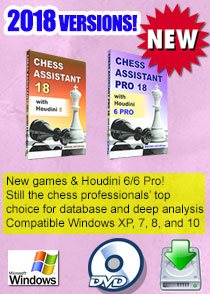


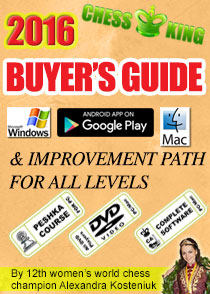


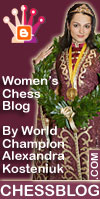






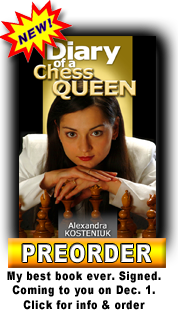










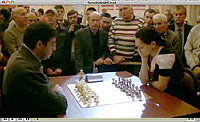
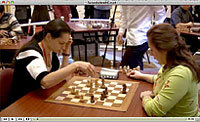
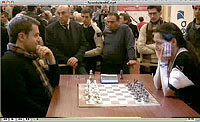
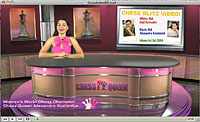
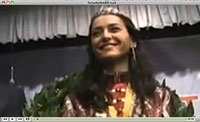

0 Comments:
Post a Comment
Note: Only a member of this blog may post a comment.
Subscribe to Post Comments [Atom]
<< Home